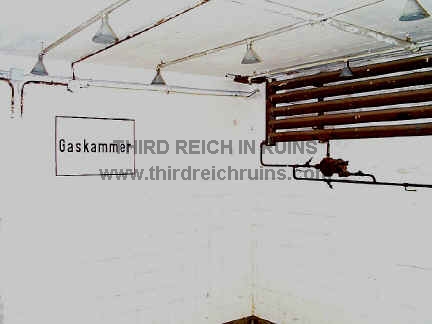Austrian Nazi death camp brings out its history at last
Mauthausen the latest to open a visitor centre
Ian Traynor in Mauthausen
Monday May 12, 2003
The Guardian
A pale grey motor powering a fan was used by the Nazis to extract fumes from the Austrian gas chamber in which 3,500 concentration camp inmates were murdered. On a hillside above the Danube yesterday, the fan and the motor were put on public display for the first time since the second world war.
Along with postcards and scribbled notes, scraps of documents and tools, computerised archives and recorded interviews with former inmates, the gas chamber fan is part of a museum opened yesterday at the Mauthausen concentration camp near the city of Linz that Hitler fantasised about making his imperial capital.
Mauthausen is perhaps the grimmest place in Austria, a hilltop fort where altogether more than 100,000 people, from countries from Spain to Russia, perished.
In a country that is good at forgetting, the concentration camp was for a long time neglected. But Mauthausen is also one of the biggest visitor attractions in Austria, bringing in more than 250,000 people every year - as many as troop through the Hapsburg palaces and museums of Vienna.
Thousands of people from all over Europe converged on the site yesterday to remember and mark the anniversary of its liberation by American troops in 1945, 58 years ago to the day.
And despite decades of Austrian amnesia about its role in the Holocaust, the new museum - an impressive squat structure of plain concrete blocks, steel and glass, located just outside the camp itself - has been built in record time by the Austrian government at a cost of €8m (£5.7m).
Its opening yesterday puts Austria alongside Germany, Poland, Hungary and the Czech Republic in the vanguard of an unprecedented boom in Holocaust tourism and exhibition-staging.
Last week at the Nazis' first concentration camp, Dachau, north of Munich, the Bavarian prime minister Edmund Stoiber opened a new museum and learning centre, eight years in the making.
Next year in Budapest, Hungary is to get its first Holocaust museum. In Poland, a £40m Jewish history complex is to be built on the grounds of the old Warsaw ghetto, razed by the Nazis 60 years ago last month. The biggest death camp, Auschwitz-Birkenau, seems to be in a permanent state of development.
In Theresienstadt in the Czech Republic, funds are being poured in to restore the Nazi transit camp that suffered colossal damage in last summer's heavy flooding.
Three years ago, Berlin got a stunning new Jewish museum; and the German political and cultural elite is still debating the pros and cons of a gargantuan Holocaust memorial for the centre of Berlin.
"Internationally, there is a great amount of fascination," says Jerzy Halbersztadt, the director of the Warsaw Ghetto project. "These new museums reflect that same phenomenon."
"The generation that lived through it is dying out and so approaches are changing," says Bertrand Perz, who was in charge of part of the new Mauthausen exhibition. "It is all about how to portray a historical era. It's more about education and art rather than just preserving these places."
The projects are attracting some of the biggest names in international architecture. Daniel Libeskind famously designed Berlin's new museum in the form of a broken Star of David. Frank Gehry, acclaimed recently for the Guggenheim in Bilbao, has drawn up blueprints for the Warsaw ghetto project.
The new approach also takes advantage of the latest technology. The centrepiece of the Mauthausen museum is an oral history project, recording interviews on audio or video with 800 survivors.
"We wanted to move the administration buildings and the visitors' centre out of the camp itself, because the survivors and their relatives were making big demands that the camp should be left in peace," says Doris Wagner, an Austrian interior ministry official who was responsible for seeing the project through.
The template and the inspiration for this building bonanza in central Europe was the Holocaust Museum in Washington, which also made full use of modern electronics and cyber-communications. It has drawn 19 million visitors, 85% of them non-Jewish, in the decade since it opened. "It captured the imagination," says Mr Halbersztadt.
But one problem with this modern, narrative approach to telling the story of the Holocaust concerns "authenticity", with staged or restored artefacts from the camps emboldening Holocaust-deniers in their allegations that material evidence of the crime has been cooked up.
The argument over authenticity makes the fan and motor, exhibited yesterday for the first time, particularly valuable.
Forensic detail on the ghastly piece of machinery was recorded at the time by an American special agent, Jack Taylor, who was interned at Mauthausen for two months after parachuting into Austria and being captured.
But the fan disappeared, hauled away by freed Czech prisoners in 1945, and lay unremarked in a cellar at Theresienstadt for decades, until it was installed - unadorned and essentially untouched - in the new Mauthausen exhibition.
http://www.guardian.co.uk/international/story/0,3604,953804,00.html
This must be the same Mr. Jack Taylor, pictured below with a Zyklon B gas introduction device, which also disappeared after the war. Rumour has it that it too ended up gathering dust somewhere in Theresienstadt.

Information on Mr. Taylor's forensic investigation of these items would be welcome.
Here, for the record, is the Mauthausen gas chamber, cunningly disguised as a shower room, right down to the functioning showerheads:





